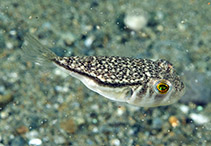| Family: |
Tetraodontidae (Puffers), subfamily: Tetraodontinae |
| Max. size: |
13 cm TL (male/unsexed); max.weight: 46.0 g |
| Environment: |
demersal; brackish; marine; depth range 18 - 22 m |
| Distribution: |
Indo-Pacific: South Africa (Knysna), Mozambique, Tanzania and Madagascar; elsewhere to Indonesia, Japan (Ryukyu Is.) and Samoa. |
| Diagnosis: |
Dorsal soft rays (total): 8-9; Anal soft rays: 7-8. This species is distinguished by the following: with spinules between nasal organs and dorsal fin
origin; upper body with dark brown reticulations; distinctive solid dark brown band from above the pectoral-fin bases to caudal-fin base; many small dark brown spots on the cheek forming broad
vertical bands separated by irregular narrow white bands; belly white (Ref. 127964). |
| Biology: |
Inhabits small loose groups on shallow coastal sand flats and in estuaries. Often sleeps during the day by burrying itself under the sand with just eyes exposed (Ref. 48637, 127964). |
| IUCN Red List Status: |
Least Concern (LC); Date assessed: 08 June 2011 Ref. (130435)
|
| Threat to humans: |
harmless |
Source and more info: www.fishbase.org. For personal, classroom, and other internal use only. Not for publication.
